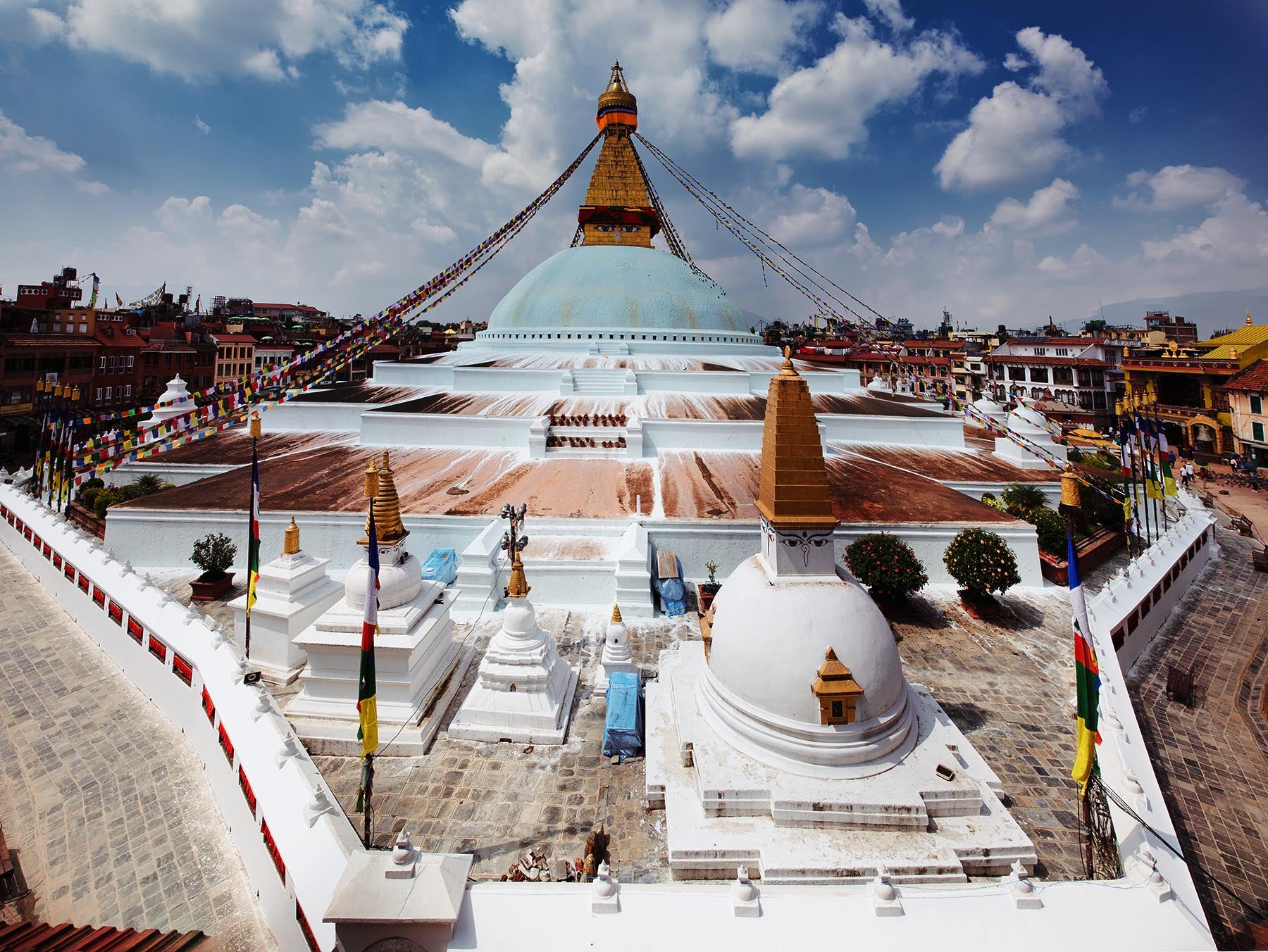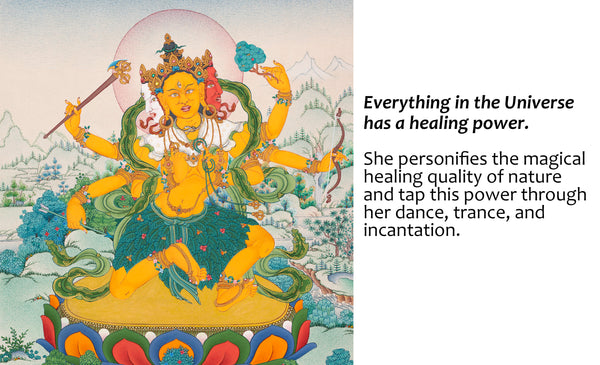The Great Stupa symbolizes the Mind of all Buddhas. This cosmological map in the shape of a mandala represents the wholeness of all the Buddhist teachings. It also represents Mount Meru, the mythical center of the cosmos.
"From form into emptiness, emptiness into form", Prajnaparamita, the Heart Sutra. This is one of the core texts for all Buddhist teachings. The form of a stupa has become the greatest symbol of Buddhism. This form symbolizes the emptiness from which all form arises.
The inner space of the stupa is full of sacred mantras, statues, blessed objects, and offerings. It symbolizes a mind of purity.
Sacred objects like relics of Kasyapa, a Buddha from a previous eon, lie within. 100 million Buddhas dissolved into the stupa adding to it their precious remains.
It is also said that the stupa itself is the representation of Buddha's body. And the relics are the life force that flows through it.
The outer form of Boudhanath Stupa consists of sacred geometry. Each shape holds a profound meaning. The whole structure is a multivalent spiritual and cultural edifice. It encompasses the whole Vajrayana teachings in a single form.
Why is Boudhanath Stupa called a Wish-Fulfilling Gem?
It is believed that circumambulating the Great Stupa and prostrating before it with a pure heart results in good karma. The stupa is very auspicious and powerful. It is also said that the gates of hell and rebirth in the lower realms are closed to those who worship here.
The powerful and compassionate blessings of the Stupa are beyond imagination. Beyond the expression of the Buddhas of the past, present, and future.
"For these stones were laid in order to bring in- conceivable joy to humanity. Whatever prayer is offered, all wishes will be granted and even supreme realization and spiritual power shall be given."
Meditators, yogis, and yoginis pray here with great devotion for protection, inspiration, blessings, and granting of wishes. “All supplications and aspirations made here will be effortlessly and spontaneously accomplished, just as with a precious wish-fulfilling jewel."
Significance of Boudhanath Stupa in Tantric Buddhism
The Stupa also symbolizes the complex system representing the Dharma teaching, path, realizations. It also represents the enlightened qualities embodying the culmination of Dharma practice.
The Great Stupa is entwined with the 8th-century Tantric master- Guru Padmasambhava. He gained realization through practice in the Yanglesho cave in Nepal. And he is believed to have secretly concealed mystic treasures for rediscovery at the Boudha stupa. These hidden treasures are called Terma.
The Stupa is a physical form filled with physical treasures. It is a power hub to discover great spiritual insight.
The history of the stupa was revealed as a terma by Tertön Lhatson Ngonmo. He again hid the treasures at Samye monastery in Tibet. Later in 1512, it was discovered by Ngakchang Shakya Zangpo while renovating the place. He then traveled to Nepal and started the restoration of the Boudhanath Stupa.
Longchen Nyingthig is one of the greatest revelations found on the Boudhanath stupa. It is a profound yogic instruction revealed by Jigme Lingpa, a great Tibetan practitioner of the 18th century. He had a vision of himself riding on a snow lioness and traveling to the Stupa from Tibet.
On the eastern side of the stupa, a wisdom Dakini handed him a sealed wooden casket. It contained mystical teachings, the Heart Treasure of Samantabadra. It was the Symbol of Infinite Mind and the Dakini's Great Secret Treasure. Inside he discovered five scrolls of yellow parchment and seven small crystals.
The all-seeing eyes of the Boudhanath stupa have witnessed many changes in its surrounding, for a really long period of time. There have been dramatic physical changes. With the increasing urbanization and population, the stupa stands as a symbol of the eternal.
Boudha has become a hub for more than fifty Buddhist monasteries and nunneries, full of monks from the Himalayan regions. It is a recognized, global center for the study of Mahayana and Vajrayana Buddhism. In 1979, Boudhanath Stupa was recognized as a UNESCO World Heritage site.
The Formation of Stupa:
The word Stupa in Sanskrit literally means Heaps. It is a mound-like hemispherical structure and contains relics. The architecture was developed from pre-Buddhist Indian mounds in which the remains of kings and heroes were burried. In the 3rd century BCE, practitioners had refined the stupa to reflect Buddha's teachings.
The traditional mound was initially made of earth. It was elevated on top with a circular platform. And topped with the pinnacle, in the shape of a cone or spire. It is now a uniquely Buddhist structural design.
In the 2nd century BCE, the great king Ashoka commissioned a Sanchi stupa in central India. He promoted Buddhism throughout his reign. The design of the stupa perfectly corresponds to the proportions of the Buddha's body. The shape represents Buddha as crowned and sitting in a meditation posture. He seats on his Lion's throne. The four sides of the base are the four qualities of the mind: love, compassion, joy, and equanimity. It is filled with precious jewels.
The gates are the four definitive events of the Buddha's life.
Eastern gate with his birth:
Western gate with his first sermon,
Southern gate with his enlightenment,
Northern gate with nirvana.
The base, touching the Earth, is a constant reminder to us that Buddha was a human being. The tower represents enlightenment itself.
In another view, the stupa also represents the elements that compose the universe.
The square base represents earth.
The hemispherical dome or vase represents water.
The conical tower represents fire.
The upper lotus parasol and the crescent moon represent air.
The sun and the dissolving point represent the element of space.
The Boudhanath stupa contains the actual bone relics of Buddha. It vividly symbolizes the Buddha's enlightened mind and his presence.
This stupa is one of the greatest examples of sacred architecture. A shape symbolizing perfection - a perfect form and symbol. The dome reminds us of fields of inner emptiness. The upward steps symbolize the progress of the mind towards enlightenment.
The center wooden pole is a life tree that links all worlds and provides protection. The lotuses support the stupa and arise as perfection from the mud of samsara. Altogether, they lead us to the unshakable stable state, our original "unbornness".
As a tantric Buddha Stupa, it provides access to sacred Terma treasures. Packed with teachings, the jewel at the top of its head symbolizes realization. It is the peak of Mount Meru, the cosmological center of the universe. The incredible dome represents the field of emptiness from which all things arise. The base is the wisdom of equanimity. Each aspect reminds us of contemplation and reflection, brimming with meaning and symbolism.
Within the center, there is a wooden sogshing pole covered with gems. Thousands of golden mantras rise vertically through the structure, from the earth to heaven and all-pervading awareness.
THE STUPA AS MOUNTAIN:
Great mountains remain unmoving in a transient world.
Likewise, Boudha stupa as the center of devotion is as stable as a mountain. The movement of circumambulation revolves around the firm's unmoving center discovered within.
The Tibetan text describes the stupa as representing the dharmakaya.
"Namo guru!
This great stupa symbolizing the dharmakaya,
The sublime wisdom mind of all the buddhas,
Shines bright like the sun throughout
all the realms of existence and quiescence "
Great Liberation Upon Seeing', to you I pray!
I dedicate all my merits to the infinity of beings throughout the vast reaches of the universe." -
JAMYANG KHYENTSE CHÖKYI LODRÖ
Here, the dharmakaya is understood as the absolute essence of the universe, the unity of all things and beings. The dharmakaya is beyond existence or non-existence, and beyond concepts.
Lama Zopa Rinpoche defines dharmakaya as "A wisdom free from all subtle and temporary obscurations, able to see the past, present, and future."
Rinpoche Chogyam Trungpa defined dharmakaya as “the basis of the original unbornness".
While making a full round of the stupa, we return to where we started. After an exploration from its base to the peak in all four directions, it is a surely wish-fulfilling gem packed with relics and blessings.
Boudha stupa represents the embodiment of Dharmakaya, ultimately free of all conceptual meaning. This wish-fulfilling site is hence, a vibrant and profound place in each of us. Practitioners come here with deep devotion. Circumambulation is a way to honor the Buddha's teachings and purify one's awareness.
May the Buddha dharma flourish and may the lives of its holders remain secure!
May the turmoil of this age be pacified and may the splendors of happiness and virtue increase!
May everyone-male and female, living or dead-who has any connection with you
Be brought swiftly to supreme and unsurpassable awakening!
Source: Boudha, Restoring the Great Stupa | Carroll Dunham


